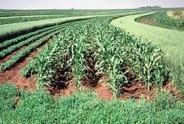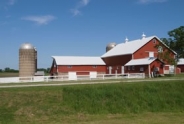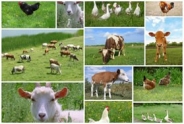Growing Degree Days: Another Tool in the Harvest Toolbox
Katelyn Miller, Field Crops and Forage Specialist
Southwest New York Dairy, Livestock and Field Crops Program

Growing degree days (GDD), or heat units, help estimate the growth and development of certain crops. Research shows that using GDD accumulations, instead of calendar days, gives a more accurate estimate of physiological development. To calculate GDD, add the high and low temperatures for the day, divide by two to get the average, then subtract the base temperature.
Formula: GDD = (Tmax + Tmin) / 2 - Base temperature
We use base and maximum temperatures because little plant growth occurs outside of the designated values. For corn and soybeans, we use the base temperature of 50?°F and a maximum temperature of 86?°F, also referred to as the 86/50 method. For example:
- Recorded high temperature: 80?°F
- Recorded low temperature: 60?°F
- GDD = (80 + 60) / 2 - 50 = 70 - 50 = 20 GDD
GDD's can help predict corn maturity. Certain seed brands provide estimates of GDD's needed for different hybrids, but these numbers need to be used with caution.
- The listed values are often from planting to physiological maturity (black layer), which is past silage harvest timing. A rule of thumb is to subtract 150 GDD's from this number to estimate the number needed for silage harvest.
- Studies have shown some variation in the GDD's required from planting to silking. This variability can happen because of factors other than heat, such as moisture and fertility.
Research conducted by Dr. Bill Cox shows that there is reduced variability tracking GDD accumulation from silking to harvest timing. While there is still some variability in this measurement, it takes out the inconsistency in the early season from planting to silking. For whole plant dry matter (DM) at harvest, a target of 32% DM is used in this study, though 35% DM is ideal. Therefore, the GDD values listed in the chart below offer a warning for harvest.
Table: Approximate Growing Degree Days needed from silking to silage harvest
Once corn begins dry down, we can anticipate an average rate of dry down of 0.5% per day. This indicates that the crop may reach 35% DM approximately six days after reaching the targets for 32% DM. At this point, sample the field and measure DM. This will help further refine harvest timing, as GDD's should not be used as a standalone tool.
You can also use GDD's to track alfalfa harvest, but it's a bit more challenging. For alfalfa, the base temperature is 41?°F, but there is not a well-established maximum temperature. Alfalfa growth is optimal between 60 - 80?°F, and temperatures over 86?°F can slow or stop growth. For alfalfa, GDD's are primarily used to estimate alfalfa's nutritive value, especially for first cutting. Generally, 700-750 GDD's will help achieve an NDF value between 35 and 40%. Later in the season, physical measurements of maturity and height are used to estimate nutritive value.
Growing Degree Days (GDD) are a valuable tool for estimating crop development and optimal harvest timing. Whether tracking corn maturity or alfalfa harvest, using GDDs alongside other measurements can help improve decision-making and ensure better crop management. Tools like the Climate Smart Farming Growing Degree Day Calculator can simplify the process and offer more precise estimates for your specific location.
Resources
"Record silking/tasseling dates for corn fields": https://ecommons.cornell.edu/server/api/core/bitstreams/5a5c472d-0fa1-452a-abd4-929ebcb9feec/content
Climate Smart Farming Growing Degree Day Calculator: https://climatesmartfarming.org/tools/csf-growing-degree-day-calculator/
Upcoming Events
Memoir Reading: Barn Gothic
December 4, 2025
Bath, NY
Barn Gothic is an elegy for family farmers and an intimate portrait of three generations laboring to be fathers and sons while their livelihood falls apart. Beautifully told with a farmer's restraint and a poet's grace, it is a story of personal loss amid corporate corruption and of finding a way forward when everything you know disappears.
NY Small Farms Summit 2025: Stronger Together
December 5, 2025
Alfred, NY
We hope you will join us on December 5th for the 2025 New York Small Farms Summit! This is an opportunity to meet other farmers and ag supporters, learn about research and education projects, and set priorities for future efforts to grow small farm success.
At the Allegany County site, we will focus on giving trees a chance and how trees build resiliency on small farms. Whether attracted to fruit, nuts, vegetables, fodder or shade, trees can be an integral part of a successful farming system. Join us as we explore the opportunities for resiliency that come from adding tree crops or managing wooded areas of your farm for agroforestry or silvopasture systems.
Crops, Cows & Critters - Southwest New York Dairy, Livestock & Field Crops Newsletter Sponsorship
December 19, 2025
Our two forms of publications feature research-based and timely information from our four specialists, listed to the right, along with local event notifications and Cornell University outreach. This information is provided to participants who range from dairy, livestock, and field crops producers to agricultural suppliers and consultants.
Weekly Email Update: Shared with 625+ households who have signed up with our program.
Monthly Paper Mailer: To reach our stakeholders and farmers who lack internet access, we send out a monthly mailer where your company's logo and contact information would be featured with a mailing list of 330+ households.
If you sponsor our weekly and monthly publications you reach approximately 955 households.
Visit our website to view our newsletters!
Announcements
No announcements at this time.





